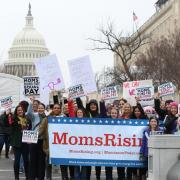40 million people in the United States don’t have access to a single paid sick day. In fact, nearly 80% of low wage workers and 40% of private sector workers don't have access to a single paid sick day. And this means that many people have little choice but to go to work sick--rather than staying home to get better and risk losing a day’s pay or even losing their job. [1]
It doesn’t have to be this way. A new study estimates that if there had been a national paid sick days policy in place in 2009, 5 million (!!!) cases of the flu could have been avoided during the H1N1 pandemic. [2]
*Tell your U.S. Senators: Paid sick days are critical for American families’ economic security. It’s not okay for families to be one virus away from losing income or becoming unemployed. We need you to support and pass the Healthy Families Act.
http://action.momsrising.org/sign/healthyfamilies/

Why are paid sick days so important?
It’s pretty obvious why paid sick days are good for public health: They help contain health care costs through prevention, early detection, and treatment of illness. With paid sick days, families will not be forced to send sick children to school where they will likely infect classmates and teachers; workers with paid sick days would not spread illness to their coworkers and customers.
Somewhat less obvious but equally true is that providing paid sick days turns out to be smart business too. Research shows that the costs of replacing workers, including advertising for, interviewing and training new employees often far outweighs the cost of retaining employees by offering paid sick days. [3] Additionally, presenteeism, when workers come to work sick, costs the nationally economy about $160 billion a year in lost productivity versus absenteeism. [4]
The Healthy Families Act (H.R. 1876, S. 984) would set an important national standard for paid sick days. Its passage would be a critical step toward meeting the health and financial needs of working families.
The Healthy Families Act would:
- Allow workers in businesses with 15 or more employees to earn up to seven job protected paid sick days each year to be used to recover from their own illness, access preventive care, or provide care for a sick family member.
- Allow workers who are victims of domestic violence, stalking, or sexual assault to use their paid sick days to recover or seek assistance related to an incident
- Include a simple method for calculating accrued sick time. Workers would earn a minimum of one hour of paid sick time for every 30 hours worked, up to 56 hours (seven days) per year, unless the employer selects a higher limit.
- Allow employers to require certification if an employee uses more than three paid sick days in a row. For victims of domestic violence, the certification may be from a law enforcement officer or victim advocate
- Allow employers to continue using their existing policies, as long as they meet the minimums set forth in the Healthy Families Act (for time, types of use, and method of use)
Why take action now? Its flu season right now, and…election season is right around the corner. We need to make sure that our elected officials know that support of paid sick days is important to us.
*Urge your U.S. Senators to pass and support the Healthy Families Act so in years to come we’ll have millions fewer cases of the flu:
http://action.momsrising.org/sign/healthyfamilies/
 And don’t forget to pass this on to your friends and family so they can take action too. Posting the link above to your Facebook page is a great way to help grow the MOMentum for paid sick days!
And don’t forget to pass this on to your friends and family so they can take action too. Posting the link above to your Facebook page is a great way to help grow the MOMentum for paid sick days!
[1] U.S. Department of Labor, Bureau of Labor Statistics. (2010, March). Employee Benefits in the United States: Selected paid leave benefits: Access, National Compensation Survey (Table 6)
[2] Kumar, S. et al. (2012, November 17). “The Impact of Workplace Policies and Other Social Factors on Self-Reported Influenza-Like Illness Incidence During the 2009 H1N1 Pandemic.” American Journal of Public Health, 102(1).
[3] Christine Siegwarth Meyer, et al, Work-Family Benefits: Which Ones Maximize Profits?, Journal of Managerial Issues, vol. 13, no. 1, Spring 2001.
[4] Stewart, W. et al. (2003, December). Lost Productive Health Time Costs from Health Conditions in the United States: Results from the American Productivity Audit. Journal of Occupational and Environmental Medicine, 45. Retrieved 22 April 2011



The views and opinions expressed in this post are those of the author(s) and do not necessarily reflect those of MomsRising.org.
MomsRising.org strongly encourages our readers to post comments in response to blog posts. We value diversity of opinions and perspectives. Our goals for this space are to be educational, thought-provoking, and respectful. So we actively moderate comments and we reserve the right to edit or remove comments that undermine these goals. Thanks!